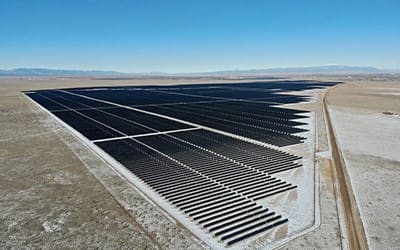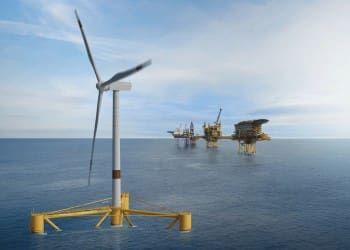![Major Moves[87]](https://esgreview.net/wp-content/uploads/2024/10/major-moves87.jpg)
Oil prices have been all over the place. Downward pressure from potential OPEC+ supply increases is being counteracted by upward momentum from falling interest rates in the United States and stimulus packages in China which could boost demand and help offset higher supply.
At least for now, the supply side of the equation seems to be counteracting prospects of higher demand, with West Texas Intermediate (WTI) crude oil prices hovering around their lowest level in 2024 at just US$70 per barrel. For context, WTI prices averaged US$68.17 per barrel in 2021, US$94.53 in 2022, and US$77.64 in 2023. Meanwhile, Henry Hub natural gas prices remain below US$2 per MMBtu. Many companies can still thrive at these levels, but there is a growing rift forming between the strategic direction of major integrated oil and gas majors. Some companies are using their treasure trove of resources to double down on oil and gas, others are taking a balanced approach, and some are even going further in the direction of renewables.
Here’s a breakdown of recent notable moves by the oil majors and why we continue to see differences grow between these former peers.
Chevron
It’s been over a year since Chevron announced its US$53 billion deal to acquire all the outstanding shares of Hess in an all-stock transaction. Hess holds a 30% non-operated interest in the coveted Stabroek block offshore Guyana. The other stakeholders, ExxonMobil and CNOOC, filed arbitration claims against Chevron and Hess in an effort to block the deal. The overhang of uncertainty has been challenging for Chevron as it attempts to adjust its strategy and chart a path forward with or without Hess.
However, Chevron got some much-needed good news from the Federal Trade Commission (FTC), which completed its antitrust review of the company’s merger with Hess. The FTC will allow the deal to go through, but Hess chief executive officer (CEO), John Hess, will not be appointed to Chevron’s board of directors and will instead serve as an advisor to Chevron on government relations and social investments in Guyana.
On October 7, Chevron Canada Ltd., an indirect subsidiary of Chevron, and a related entity announced that it would sell its 20% non-operated interest in the Athabasca Oil Sands Project, 70% operated interest in the Duvernay shale, and related interests, all located in Alberta, Canada, to Canadian Natural Resources Ltd. Chevron expects the US$6.5 billion deal to close in Q4 2024. In 2023, the assets only contributed 84,000 barrels of oil equivalent per day (boe/d) to Chevron (net of royalties). Chevron categorized the sale as part of its initiative to divest US$10 billion to US$15 billion in assets by 2028 to optimize its energy portfolio.
Chevron continues to steer its asset portfolio toward areas with low costs of production. It has ramped investments in the Permian Basin and hopes that Guyana could serve to diversify its interests to include international offshore developments rather than be overly focused on US shale.
ExxonMobil
Unlike Chevron, ExxonMobil faced little pushback to its blockbuster deal. ExxonMobil completed its US$59.5 billion acquisition of Pioneer Natural Resources (Pioneer) in May, which pole-vaulted the oil major to the largest producer in the Permian Basin. Pioneer has already contributed to ExxonMobil’s bottom line, bringing in US$540 million in Q2 2024 operating earnings.
Pioneer has helped push ExxonMobil’s production over the 4.2 million barrels of oil equivalent per day it initially expected to accomplish by 2027 (according to its 2023 corporate plan). With the oil and gas portfolio humming along, ExxonMobil is setting its sights on ramping up its carbon capture and storage (CCS) business. CCS is the core focus of ExxonMobil’s Low Carbon Solutions division, which received a big boost when ExxonMobil bought Denbury for US$4.9 billion last year (see “ExxonMobil Buys Carbon Capture Company Denbury,” September 2023 Gas Compression Magazine, p. 38).
In October, ExxonMobil took its CCS business a step further when it executed the largest offshore carbon dioxide (CO2) storage lease in the US with the Texas General Land Office (GLO). The over 271,000-acre (109,670 ha) site complements ExxonMobil’s onshore CO2 storage portfolio and could help the US Gulf Coast become a CCS leader. The offshore acreage provides ExxonMobil with storage space for CO2 emissions and supports ExxonMobil’s CO2 pipeline network, which is the largest in the US.
BP
A report by Reuters said that BP “has abandoned a target to cut oil and gas output by 2030 as CEO Murray Auchincloss scales back the firm’s energy transition strategy to regain investor confidence.” The new strategic direction marks a noticeable shift away from the ambitious climate targets BP unveiled in 2020. BP had a goal to cut oil and gas production by 40% by 2030.
To its credit, BP has already cut emissions by more than 20% against its 2019 baseline, which was a goal it initially intended to hit by 2025. However, the recent shift in strategic direction could jeopardize BP’s stated goal to reduce emissions by 50% by 2030 from its 2019 baseline, especially because that goal was predicated on reducing oil and gas production.
On September 16, BP announced it would divest its US onshore wind business to focus on onshore renewables in Lightsource BP. BP Wind Energy has interests in 10 operating onshore wind energy assets across seven US states, operating nine of them. The assets have a combined gross generating capacity of 1.7GW (1.3GW net to BP). BP said it intends to sell BP Wind Energy as an integrated business, with its workforce expected to transfer to the new owner on completion of a sale. BP intends to launch the sale process shortly.

In November 2023, BP announced its agreement to take full ownership of Lightsource BP, its solar power developer joint venture. On completion of this acquisition – anticipated before the end of this year, subject to regulatory approvals – BP intends to support Lightsource BP’s continued growth and extend its capabilities as a developer of utility-scale renewable power assets worldwide for both solar and onshore wind. BP believes the move will help it meet its own demand for low carbon power as well as helping customers decarbonize their operations.
TotalEnergies
French integrated major TotalEnergies continues to take a balanced approach to the energy transition. The company is shifting its fossil fuel portfolio toward natural gas and investing in renewable energy. TotalEnergies said that natural gas could account for 50% of its energy mix by 2030. The company is taking strides to limit methane emissions generated by the production and transportation of natural gas by maintaining a methane intensity below 0.1% of commercial gas produced and targeting an 80% reduction in methane emissions by 2030. To renew its gas portfolio and develop its exploration strategy, TotalEnergies has made significant gas investments, particularly in the UK portion of the North Sea and the United States.
TotalEnergies has made several leaps in recent months to develop its wind energy portfolio. In June, TotalEnergies, as shareholder of Offshore Wind One GmbH, was awarded the maritime concession N-11.2 by the German Federal Network Agency, following auctions held in Germany. The concession will enable TotalEnergies to build a 3.5-GW offshore wind hub in the German North Sea. The company hopes to benefit from the synergies between this new lease and the 2-GW concession N-12.1 won last year.
In September, TotalEnergies launched a floating wind turbine pilot project that will supply renewable power to the Culzean offshore platform in the UK North Sea. Expected to be fully operational in 2025, the floating wind turbine will supply around 20% of Culzean’s power requirement.

In October, TotalEnergies signed an agreement with RWE to acquire a 50% stake in two offshore wind projects in the North Sea. These two projects, N-9.1 (2 GW) and N-9.2 (2 GW), were awarded to RWE in August 2024, have 25-year licenses extendable to 35 years, and are scheduled to be commissioned in 2031 and 2032, respectively.
As part of its ambition to get to net zero by 2050, TotalEnergies is building a portfolio combining renewables (solar, onshore, and offshore wind) and flexible assets (CCS) to deliver clean firm power to its customers. At the end of 2023, TotalEnergies’ gross renewable electricity generation installed capacity was 22 GW. TotalEnergies will continue to expand this business to reach 35 GW in 2025 and more than 100 TWh of net electricity production by 2030.
Equinor
Equinor has been aggressively investing in alternative energy to hit its environmental, social, and governance (ESG) goals. In 2022, Equinor invested 14% of its capital expenditures in low-carbon solutions but plans to make low-carbon 30% of gross investments by 2025. To make good on that promise, Equinor has kept a lid on oil and gas production and chosen instead to invest excess profits mostly in renewable energy, stock repurchases, and dividends.
Equinor made a splash in October when the Norwegian oil and gas and renewable energy company acquired 41,197,344 shares in Ørsted A/S (Ørsted), corresponding to 9.8% of the shares and votes in the company. The transaction establishes Equinor as the second largest shareholder in Ørsted, after the Danish State, which holds a controlling stake in the company. The Norwegian state has a controlling stake in Equinor. Equinor said it is supportive of Ørsted’s strategy and management and is not seeking board representation.
Ørsted has a net renewable generation capacity of around 10.4 GW, and a gross portfolio of offshore wind projects in execution of around 7 GW. The company’s ambition is to achieve a gross installed renewable capacity of around 35 to 38 GW by 2030.
Despite its steadfast optimism that hydrogen will be a key contributor to the energy transition, Equinor and Shell are citing weak demand as cause for putting some of their biggest hydrogen projects on hold. In late September, Equinor announced that it was abandoning plans to export blue hydrogen to Germany due to a lack of demand and unjustifiably high capital costs. In January 2023, Equinor and German energy major, RWE, announced a partnership to develop large-scale value chains for low carbon hydrogen. The idea was to replace coal-fired power plants with hydrogen gas-fired power plants, with Equinor and RWE jointly owning the new gas plants. Germany has a goal to phase out all coal-fired power plants by 2030.
The companies planned to produce blue hydrogen, which is hydrogen from natural gas using carbon capture and storage, and the transport that hydrogen via pipeline from Norway to Germany. According to Equinor, more than 95% of the CO2 would be captured and stored safely and permanently under the seabed offshore Norway. Equinor has spent decades drilling oil and natural gas offshore Norway and has built multiple offshore wind farms in the North Sea and other major bodies of water. Equinor hoped to produce green hydrogen from some of its offshore wind farms to help power industrial customers.
Shell
Just days after reports surfaced of Equinor’s canceled projects, Shell decided to scrap its plans for its hydrogen hub in Norway. In July 2021, Aker Clean Hydrogen and CapeOmega signed a MoU with AS Norske Shell to explore opportunities to develop the Aukra Hydrogen Hub to a large-scale production facility for clean hydrogen using natural gas from the local gas processing plant. The consortium had a goal to utilize 250 MW of renewable power from existing onshore grid capacity to produce 1089 tons (1200 tonnes) per day of blue hydrogen by 2030 and then double capacity by 2035 using blue hydrogen and green hydrogen from offshore wind farms. Like Equinor, Shell blamed market dynamics for the project’s downfall.
The news is a setback for the natural gas, hydrogen, and offshore wind industries and a reminder that the hydrogen economy needs a reliable network of hydrogen producers and consumers to thrive. It also shows that even the biggest players with the deepest pockets are struggling to justify the funding of hydrogen megaprojects. Technological advancements and the build out of infrastructure can help scale the European hydrogen economy to make it more cost effective over time. The two discussed project disruptions shed light on the need for reliable and clear hydrogen policy and government funding from Germany and Norway to make hydrogen a worthwhile choice for energy majors looking to achieve their ESG goals.
Stubborn Advantages
A few years ago, it was a mad scramble among the majors to save face and position themselves on the right side of the energy transition. Now, we are seeing the majors go their separate ways, influenced by myriad factors from existing constraints, policy influences by their host countries, financial health, and competitive advantages.
It may take 5 or 10 years, but eventually we could cease grouping the majors under one umbrella, and instead, separate them based on their strategic direction. ExxonMobil could grow to become an oil and gas/CCS hybrid. Equinor and TotalEnergies could gradually decarbonize their operations thanks to aggressive renewable energy investments.
Investments made by oil majors carry more weight than their headline value. They send ripple effects throughout the industry, acting as stamps of approval or disapproval and shaping the global future energy mix. Monitoring these major moves can help keep a finger on the pulse of the oil and gas industry.


















